- Home
- Level-3 Commission Texas Security Officer Course
Curriculum
- 13 Sections
- 15 Lessons
- 4 Days
- Introduction and Disclaimers3
- Chapter 1: Level-3 Commission Texas Private Security Course1
- Chapter 2: Level-3 Commission Texas Private Security Course1
- Chapter 3: Level-3 Commission Texas Private Security Course1
- Chapter 4: Level-3 Commission Texas Private Security Course1
- Chapter 5: Level-3 Commission Texas Private Security Course1
- Chapter 6: Level-3 Commission Texas Private Security Course1
- Chapter 7: Level-3 Commission Texas Private Security Course1
- Chapter 8: Level-3 Commission Texas Private Security Course1
- Chapter 9: Level-3 Commission Texas Private Security Course1
- Chapter 10: Level-3 Commission Texas Private Security Course1
- Chapter 11: Level-3 Commission Texas Private Security Course1
- Chapter 12: Level-3 Commission Texas Private Security Course2
INTERMEDIATE WEAPONS

Expandable batons, straight batons, electroshock devices, and chemical dispensing devices such as oleoresin capsicum (OC) spray are often called intermediate weapons. These intermediate weapons are utilized as a reasonable force option against individuals demonstrating threatening resistance, —meaning someone who poses an articulable threat of harm, to the security officer or another person.
Authority to Carry
The Texas Department of Public Safety Regulatory Services Division website specifies and explains the current restrictions on clubs and chemical dispensing devices. TCTA note: There is a slight issue we need to point out about DPS’ statement on OC Pepper Spray whereas they state only Commission (Armed) Security officers can carry OC and not Unarmed security officers- this is incorrect as the Penal Code defines “Security Officers” as both armed and unarmed, so it is not against the law for an unarmed security guard to carry a non-firearm/ less than lethal weapon.
Baton
Batons fall under the definition of clubs. The carrying of a club is generally prohibited by Penal Code Section 46.02. Under Section 46.15(b)(4) and (5), a commissioned security officer that is either engaging in the performance of their assignment or is traveling to or from their assignment in full uniform is exempt from the prohibitions of 46.02. Section 46.03 prohibits the carrying of a club in numerous specific places and provides limited defenses relating to the premises of a racetrack or the secured area of an airport (see sub. (d) and (h), respectively). There is no certification specific to the carrying of clubs.
Chemical Dispensing Device
The carrying of a chemical dispensing device is prohibited by Penal Code Section 46.05. Subsection (f) of Section 46.05 provides a defense to prosecution for security officers who have received training on the use of a chemical dispensing device that is either (1), provided by TCOLE (police academy) or (2), approved by the Department. The Department has approved training on the use of a chemical dispensing device when administered to a security officer who has successfully completed the board approved Level III training.
TCTA note: There is a slight issue we need to point out about DPS’ statement on OC Pepper Spray whereas they state only Commission (Armed) Security officers can carry OC and not Unarmed security officers- this is incorrect as the Penal Code defines “Security Officers” as both armed and unarmed, so it is not against the law for an unarmed security guard to carry a non-firearm/ less than lethal weapon Read the entire section of 46.05 and not just the small section DPS provides.
Controlled Energy Weapon aka “Conductive Energy Weapon”
The carrying of a Controlled Energy Weapon such as a Taser® or similar weapon is not prohibited under Texas law for armed or unarmed security officers. Neither the Private Security Act, nor the related administrative rules address the carrying of such a weapon by a security officer. There is no certification for the use of such weapons.
BATON INDEPTH:
With the correct use of a baton, a security officer has the opportunity to prevent a dangerous and assaultive individual from possibly becoming a more serious threat to the security officer or others.
The use of a baton is in response to unsuccessful de-escalation of a situation where an aggressor’s resistance has escalated the security officer’s use of force response. The physical use of the baton is intended to stop the assaultive actions of an attacker. Once threatening resistance stops, the security officer must re-evaluate the use of force options based on the current level of resistance. Always use the reasonable force necessary to gain compliance.
Nomenclature
The expandable baton contains the following parts that can be seen in the figure below
- Tip
- End Shaft
- Middle Shaft
- Handle
- O-ring
- Retaining Clip
- Cap
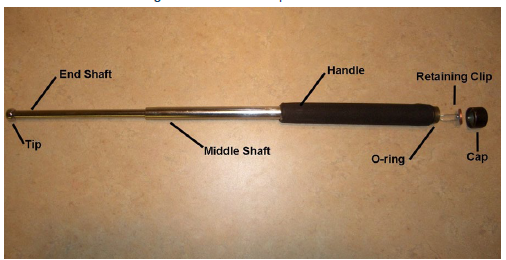
Grip of Baton
The baton should be gripped slightly above the end and should be held securely between the two middle fingers and the thumb. This grip should be applied prior to the baton being drawn. When the baton is drawn, it should be extended to its full length by forcefully swinging it at a downward forty-five-degree angle between the officer and the subject. As soon as it is fully expanded, it should be held in the interview or defensive stance.
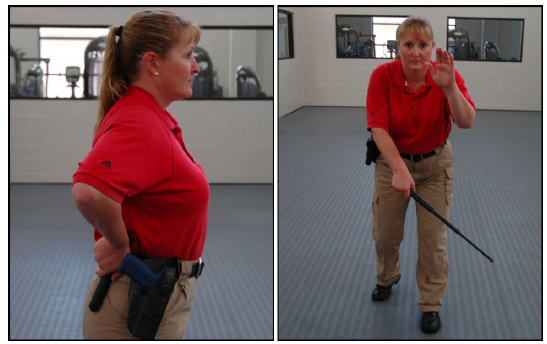
Reactionary Gap with Baton:
Reactionary Gap is the distance between the security officer and the suspect:
• When distance increases from the suspect, the security officer’s opportunity to identify and react to a threat also increases.
• A minimum distance to allow viable communication and reaction is approximately 6 feet.
• “Danger Zone” refers to an area within the reactionary gap. The security officer’s ability to react to the threat has been decreased.
• Security officers should be aware of decreased ability to react to a sudden attack.
Baton Stances:
Interview Stance-
The interview stance with a baton that is expanded to its full length is done by holding the baton behind the strong side leg and assuming a normal interview stance. This allows the baton to be immediately used if needed.
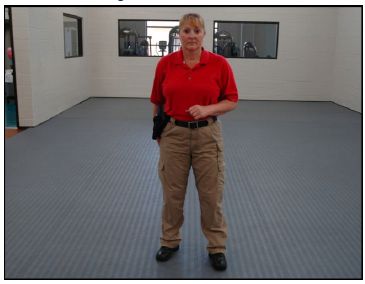
Defensive Stance-
The defensive stance with the baton is assumed when a threat is perceived that will require the baton to be used. It is assumed by deploying the baton and moving it to the crown of the shoulder or moving it from the interview stance to the crown of the shoulder. The center of gravity is lowered as the security officer takes a small step backward, increasing the reactionary gap. The butt of the baton should be pointed at the individual.
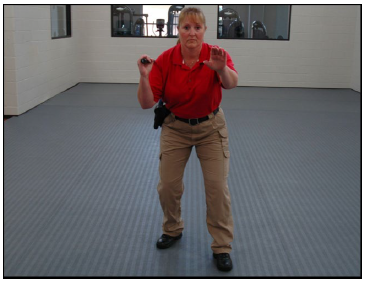
Blocks:
Blocks with the baton are actually strikes that are occurring to stop an attack that is coming at the officer. These blocks should be delivered to the meaty portion of the arm or leg that is attacking the security officer in order to temporarily disable the attacker.
Arms-
Blocks to the arms are delivered to the forearms because the individual is attempting to punch the officer. If the strike is coming from outside of the attacker’s body width, such as a roundhouse punch, then the strikes are delivered to the inside of the forearms. If the punches are coming from inside the attacker’s body width, such as a jab, then the strike is delivered to the outside of the forearm. While blocking punches with the baton, it should remain vertical to the ground. The security officer should be moving laterally towards their strong side, if possible, to get out of the way of the attacker.
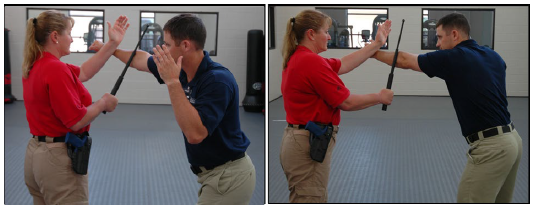
Legs-
Blocks to the legs are delivered if the individual is attempting to kick the officer. If the kick is coming from outside of the attacker’s body width, such as a round kick, then the security officer should step in slightly and deliver the strike to the thigh. If the kick is coming from inside the attacker’s body width, such as front kick, then the strike should be delivered to the side of the thigh or calf. The security officer should be moving laterally towards their strong side, if possible, to get out of the way of the attacker.
When delivering a block, the security officer should hit the individual as hard as they possibly can in order to stop the aggression and to prevent possible injury from multiple strikes.
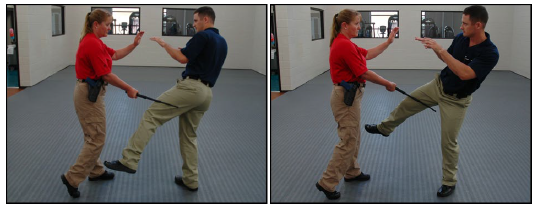
Strikes:
Primary strike areas are defined as attacking limbs and/or large muscle groups. Examples of attacking limbs include but are not limited to: arms, hands, legs, feet, gluteus maximus, and hamstrings. Strikes delivered to the head, neck, and spine are considered deadly force.
A fight is a dynamic, ever-changing encounter, and an officer is not expected to predict the subject’s movements. Unless deadly force is applicable, it is the responsibility of the officer to aim their strikes toward attacking limbs and large muscle groups and away from the head, neck, and spine. If while aiming for an appropriate target area results in inadvertent strikes to the head, neck, or spine due to the subject’s movement, the officer is justified in their use of force but will be required to articulate their actions.
Legs-
When delivering strikes to the legs, the security officer should aim at the meaty portion of the legs such as the thigh or calf. Strikes to these areas will temporarily disable the individual and rarely will cause any broken bones.
If the security officer is in front of or behind the individual, then strikes are usually applied to the thigh. The thigh can be struck on the outside, inside, front, or rear of the thigh, all of which should cause the individual to fall to the ground.
Strikes can also be delivered to the calf muscle if that target should present itself.
When delivering a strike, the security officer should hit the individual with sufficient force in order to stop the aggression and to prevent possible injury from multiple strikes. While striking, the security officer should step into the strike, in order to maximize effectiveness. Anytime a strike is delivered, the security officer should immediately return to the defensive stance in preparation of delivering more strikes if needed.
If the security officer needs to move from one side of the individual to the other while striking, the baton should be placed under the support arm in preparation of a back hand strike. The back hand strike is delivered to the opposite side of the appendage that was struck while the security officer is moving back to the defensive stance.
If the individual is still standing after delivering a power strike and is no longer a threat, the security officer can lessen his use of force by using an arm-bar control technique to ground the subject. This is done by turning the baton in the grip so that it lays parallel to the forearm of the security officer. The security officer then performs the arm-bar grounding technique using the baton instead of his wrist.
The use of a baton does not affect all subjects the same, and a security officer must always be prepared to transition to another use of force option.
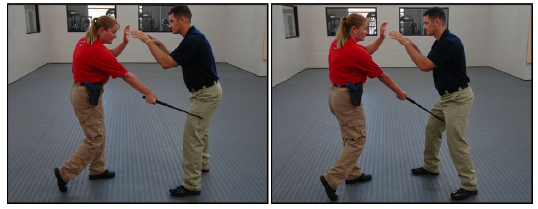
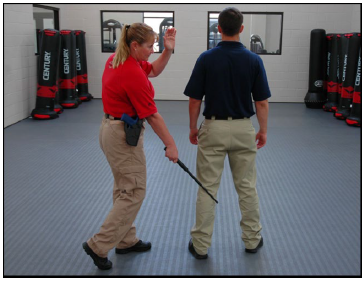
Tracing C Baton Retention Technique:
A common technique an aggressor may use is grabbing for a security officer’s baton or, in some cases, even taking the baton and using it against the security officer.
Maintaining physical control of the baton is essential for the safety of the security officer and those around them. Aggressors will generally attempt to grab the baton where they can get the strongest hold.
Security officers must resist the instinct of getting into a tug-of-war match over the baton, which often proves to be ineffective.
Using the momentum of the aggressor to pull the riot baton away, the security officer simply steps into or closer to the aggressor with their support side foot. With the momentum created the aggressor’s hold on the baton is lessened. The security officer then rapidly uses the tracing‑C technique to recover the baton.
To effectively employ the tracing-C technique:
1. Push up on the baton.
2. Pull the baton around in an upward swing as if tracing a C in the air from bottom to top with the long end.
Note: This movement seems to wrap the aggressor’s arms around themselves.
3. Drive (immediately with a quick and forceful movement) the end of the baton straight down, as if slicing the C in half.
Once the security officer reaches the top of the C and the aggressor is tied up, it is impossible for the aggressor to maintain hold of the baton. Further actions such as a strike may or may not be necessary. Officers must be able to assess the situation and react accordingly.
Summary
The use of a baton is in response to unsuccessful de-escalation of a situation where an aggressor’s resistance has escalated the security officer’s use of force response. The physical use of the baton is intended to stop the assaultive actions of an attacker. Once threatening resistance stops, the security officer must re-evaluate the use of force options based on the current level of resistance. The use of a baton does not affect all subjects the same, and a security officer must always be prepared to transition to another use of force option. Always use the reasonable force necessary in response to the resistance to gain compliance.
